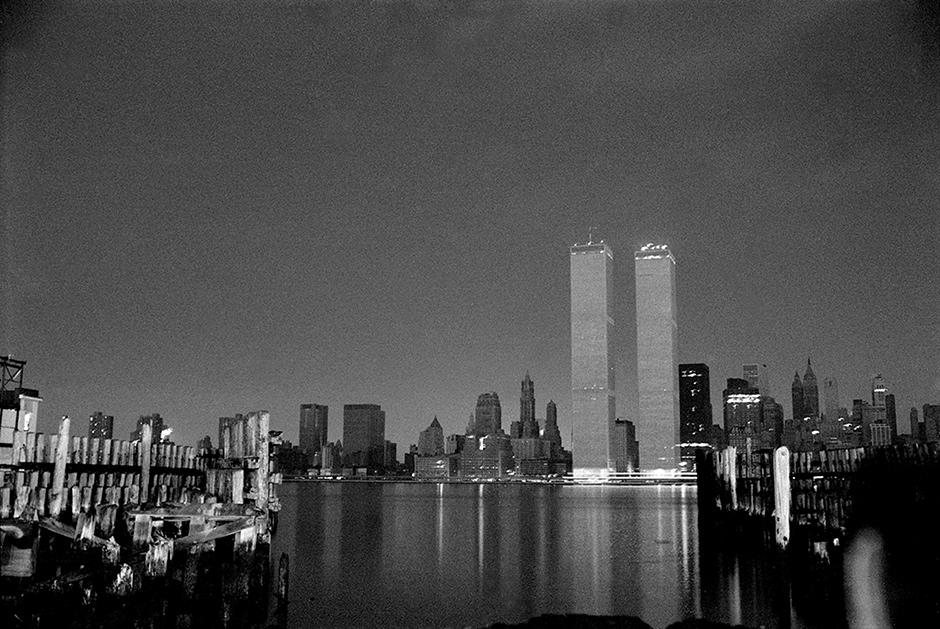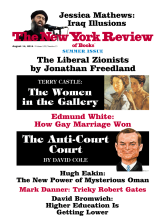In response to:
The Road to the Zombie Office from the June 19, 2014 issue
To the Editors:
I am exceedingly grateful to Martin Filler for his long, serious, and respectful treatment of my book, Cubed [NYR, June 19]. He alleges a few misinterpretations of architectural history and errors of fact, at least one of which I’d enjoy disputing (others, too, but vita brevis…), and one more of which is, less enjoyably, a proofreading error introduced by my publishers, Doubleday, that unfortunately I only discovered in his citation.
The first is his contention that, against my own description, the World Trade Center towers were “among the brightest elements of Manhatttan’s skyline” the night of the 1977 blackout. A photograph from the New York Daily News of the following day shows precisely what I describe: the towers as enormous tenebrous shafts looming over the surrounding area. Filler argues that “their reflective aluminum cladding” made them “much more visible than other skyscrapers nearby,” but I’m not sure how this is to the point. My claim was simply about their going dark in the blackout, and came in the context of a discussion about their grotesque size. I was suggesting that they were exceptionally large, dark objects, which to my eyes the photographic evidence upholds.
The second is his citation of my line about Le Corbusier, where he quotes me as referring to his “penchant for strikingly large glass panes” as his “most widely followed contribution to the discipline” of architecture. Filler writes, “This is nonsense,” and it certainly is. Sadly, this was not what I originally wrote: the error he correctly identifies was introduced by the publishers, for reasons unclear to me (and, I’m told, to them—gremlins at work). My original line, which was retained through the proof stage, was that Le Corbusier’s “penchant for strikingly large glasses [i.e., vision-correcting spectacles] might have been his most widely followed contribution to the discipline” (emphasis mine). This was of course intended as a laugh line about the high percentage of architects who took to wearing large, thick-framed glasses as an homage to Corb.
Though Filler might deplore this as yet another instance of my “callow overeagerness to deliver a punch line,” as he did with my quip about people fleeing Boston because of the falling glass of the John Hancock tower, it was nonetheless intended to be precisely that—a joke—and not the mistake it became. My publishers and I regret the error.
Nikil Saval
Philadelphia, Pennsylvania
Martin Filler replies:
Nikil Saval is indeed correct to complain about the prepublication reader’s copy of Cubed sent out by Doubleday, perhaps the most sloppily edited advance text I’ve encountered in forty years of book reviewing, not to mention the errors that made it into the finished book. It seems to me that the confusion over the author’s jocular observation about Le Corbusier indicates both an overestimation of his own comedic skills and, more importantly, a certain want of gravitas at odds with the better portions of this work. “Correcting” his publisher’s textual imposition (if that’s what it was) hardly makes any difference, however, for Saval is wrong in either case. His jest that the most pervasive contribution of the twentieth century’s most influential architect was his eyeglass frames—which were in turn copied by Philip Johnson, Paul Rudolph, and I.M. Pei, among others—is a puerile crack unworthy of a serious writer on the building art.
As for the exterior appearance of Manhattan’s World Trade Center during the 1977 blackout, I submit as contrary evidence the photo that appeared on the front page of The New York Times the day after the event. The New York Daily News picture that Saval cites was shot in silhouette toward brightly lit surrounding regions unaffected by the outage, giving the Twin Towers a darker cast in contrast to their appearance in the Times image and in the Associated Press photograph reprinted on this page, both of which show the skyline as seen from New Jersey. In any event, the Trade Center’s emergency generators kicked in only an hour and a half after the breakdown, which accounts for the ambient reflection I describe, and any darkness was of brief duration.
Clearly Saval is as fond of Stanley Kubrick’s 2001: A Space Odyssey as I am. But his comparing that film’s mysterious black monolith first to Mies van der Rohe’s Seagram Building and then again, eighty-six pages later, to the Twin Towers suggests to me either an unwarranted overconfidence or indifference to detail that undermines his largely admirable first book.




